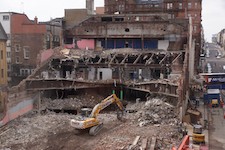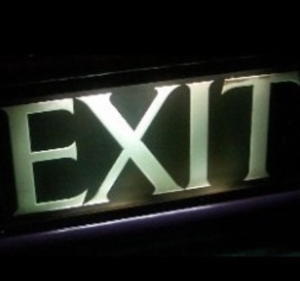Opened on December 31st
1934,
the Glasgow Paramount was one of the later cinemas built
for the chain
in Britain (which also included Manchester
and Newcastle,
amongst
several others).
The architects were Frank
T. Verity and Samuel
Beverley, who designed many of the British
Paramounts - this was
their only cinema north of the border.
Glasgow's Paramount was freestanding, and occupied half
a city
block.
The facade was built in white granite, with five
two-storey finned
windows curving around and above the corner entrance. At
night, the
entire building was outlined in neon. |

Opening
Brochure
 |

Original
Auditorium
(1960s)

Original
auditorium
|
The
main foyer had an open staircase to the upper foyer, which
looked down
onto the ground floor, and was home to a tea room and
restaurant,
situated under the tall corner windows. A further cafe was
situated
upstairs from the main restaurant (behind the windows to
the right of
the corner in the main photo above).
The auditorium sat nearly 2,800 in the circle and stalls,
and was
originally decorated in green, copper and silver. The
stage area was
spacious, with a tall full-height fly-tower, and around
fifteen
dressing rooms at the rear of the side elevation, as well
as under the
stage.
A Compton organ rose from this understage area
(remarkably, the organ
console survives, and is currently being housed in Summerlee
Heritage
Park in nearby Coatbridge, whilst it is restored by
the Scottish
Cinema
Organ Trust).
|
In
1939, the cinema, along with
all other UK Paramounts, was sold to the Odeon circuit.
Under this
name, it continued successfully until 1970, with live
shows augmenting
the film presentations. Most famously, both the Rolling
Stones and the
Beatles played at the Glasgow Odeon.
In 1970, the cinema was closed for a year and
comprehensively
remodelled. This involved stripping almost all of the
Italianate
interior out and creating 3 screens - one in the former
balcony
extended fully forward, one in the former stalls (both
seating around
1100), plus a smaller screen in the former stage area.
This latter
screen, seating 555, was formed over two levels, with a
small balcony,
and had a seperate entrance to the side of the building.
The foyers
were remodelled too, with the double height sections being
floored
over, and the main staircase realigned. The cafes were
walled off to
become
offices and staff areas, and a bar was placed in the top
foyer,
although the view from the corner windows was now sadly
blocked.
The exterior did not escape drastic modernisation either:
the corner
windows and fins were hidden behind a giant,
full
height readograph,
lit from behind, and with corrugated metal sheeting
covering much of
the granite around it.
|

1970
Screen
1

1970 Screen 2

1970 Screen 3
|
In 1988, the screen in the
original stalls area was further subdivided
into three screens, of around 220 seats each, and the balcony
and
stalls of the smaller Screen 3 were split into two, giving a
total of
six screens. Access to all screens was now from the main corner
entrance. A further subdivision in 1999 saw the 1100 seat Screen
1, in
roughly the former circle, divided into four screens, bringing
the
total to nine. The current Screen 1, at 555 seats, is now the
largest
in the complex.

|
This
refurbishment also saw the bar being removed and, happily,
the
exterior was restored to something like its former glory,
with the
removal of the readograph and corrugated sheeting, and the
re-instatement of a simplified version of the original
neon lighting
scheme. |
Sadly, only a few years later,
Odeon sold the building (along with the Odeon
Edinburgh) in
March 2003 to property developers. Two months later, Historic
Scotland
afforded the building some degree of protection with B-listed
status.
Planning permission [PDF
of
planning report] was granted in 2004 for
demolition behind a
retained facade, and the construction of a new
interior for
leisure and retail use.
The plans involve reinstatement of something
akin to the original external neon lighting scheme, and
there is
also a requirement to strip out all non-original
features to search for
any
plasterwork or other original decoration prior to
demolition starting.
It is now on the Buildings
at Risk list.
|
Current Interior (2003)
|

Decoration
on
pillar top

Detail of original decorative plasterwork
|
Despite
the
comprehensive nature of the interior alterations over
the
years, several small pockets of original decoration and
plasterwork did
remain intact.
It was
leased back to Odeon on a short-term basis whilst the
developers
completed their plans - closure finally happened 7th
January 2006, and the building was stripped
of seats, projection equipment and anything else useful.
Seating and final films on closure are shown below:
Screen 1 - 555 seats (43.5 ft screen) - King Kong,
2 - 152
(23 ft) - Harry Potter 4,
3 - 113 (22 ft) - Lassie / King Kong,
4 - 173 (25 ft) - Just Like Heaven,
5 - 192 (26.5 ft) - The Producers,
6 - 235
(26 ft) - King Kong,
7 - 253 (27 ft) - Chronicles of Narnia,
8 - 252 (33 ft) - Chronicles of Narnia,
9 - 222 (31.5 ft) - Chronicles of Narnia. |
|


























